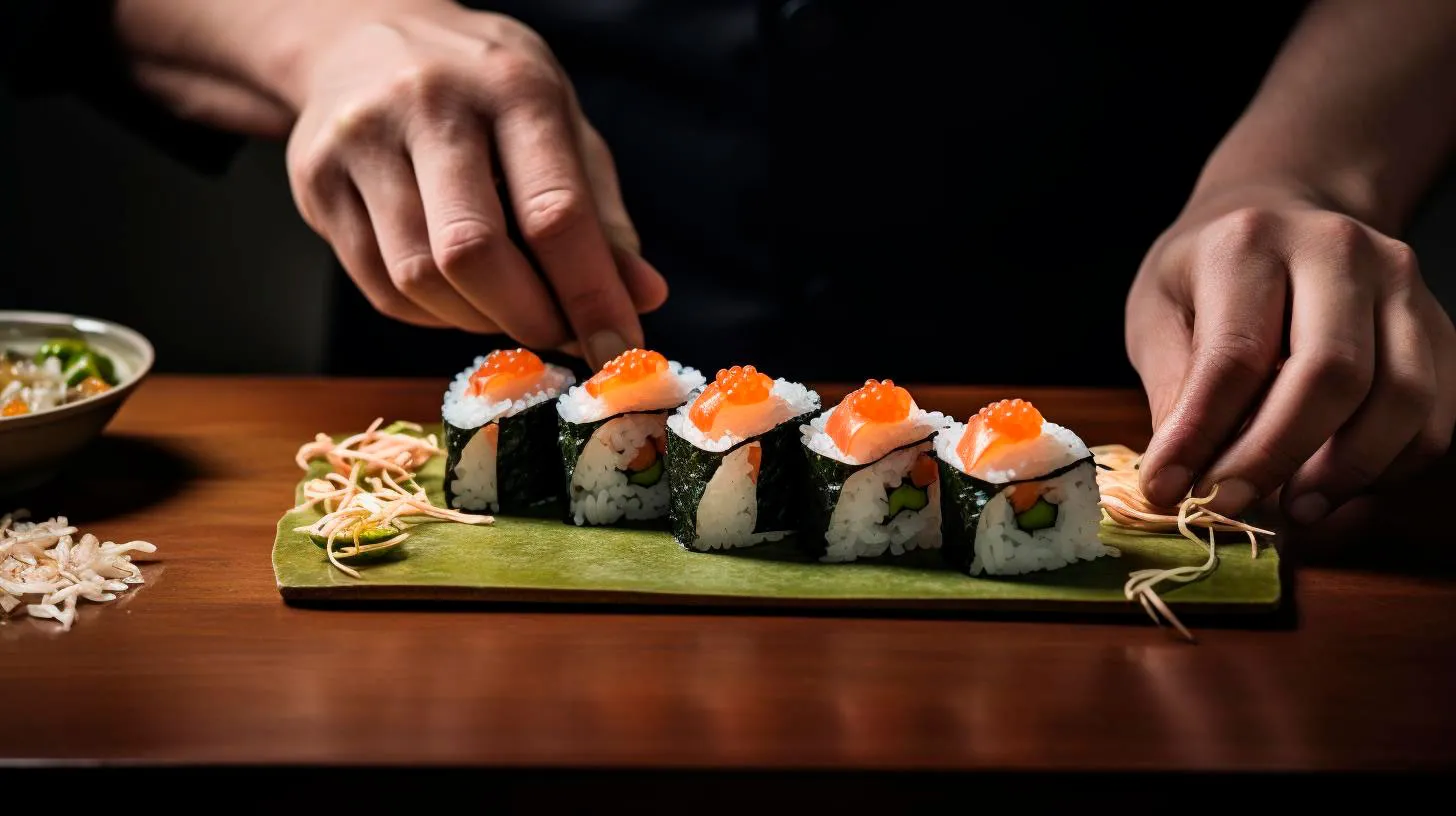Take your love of sushi to the next level
Whether you’re a sushi newbie or a seasoned connoisseur, there are always new avenues to explore within the world of sushi.
1. Master the art of sushi making
Have you ever wondered about the intricate process behind creating those perfectly rolled sushi pieces? Well, now is the perfect time to acquire that skill and become a sushi chef in your own kitchen. Learning to make sushi at home is not only fun but also incredibly rewarding.
Here are some benefits and key takeaways:
- Developing a new culinary skill: Making sushi at home allows you to expand your repertoire as a cook.
- Customizing your sushi creations: You can experiment with different fillings, toppings, and sauces, creating unique flavor combinations.
- Sharing the experience: Inviting friends or family to join you in your sushi-making adventures can be a fun and interactive way to spend time together.
According to a survey conducted by Statista, the global sushi market is expected to reach a value of $22.4 billion by 2022. This statistic reflects the immense popularity of sushi worldwide.
2. Explore different types of sushi
Sushi is not just about those familiar rolls we all love. There are numerous other types of sushi that offer distinct flavors and textures. Expand your horizons by trying out various traditional sushi styles:
- Nigiri: Nigiri sushi consists of a small mound of rice topped with a slice of fresh fish or seafood. This minimalist style of sushi emphasizes the quality of the ingredients.
- Sashimi: Sashimi is thinly sliced raw fish or seafood served without rice. It allows you to truly savor the pure taste and texture of the fish.
- Temaki: Temaki, also known as hand rolls, are cone-shaped pieces of nori seaweed filled with rice, fish, vegetables, and other ingredients. They are meant to be eaten with your hands.
- Maki: Maki sushi rolls are perhaps the most common type of sushi. They consist of rice, fish, and various other fillings rolled tightly in a sheet of nori and cut into bite-sized pieces.
By exploring different types of sushi, you’ll gain a deeper understanding of the traditional artistry and versatility of this beloved cuisine.
3. Pair sushi with the perfect beverage
Pairing sushi with the right beverage can elevate your dining experience to new heights. While green tea is a classic accompaniment to sushi, there are other interesting options to consider:
- Sake: Japan’s iconic rice wine, sake, offers a delightful complement to sushi. Its subtle flavors and smooth finish can enhance the taste of various sushi varieties.
- Japanese beer: Crisp, refreshing Japanese beers such as Sapporo or Asahi go well with sushi, especially when enjoyed on a warm summer’s day.
- White wine: Light and fruity white wines, like Sauvignon Blanc or Riesling, can provide a refreshing contrast to the umami flavors of sushi.
Statistics show that the global consumption of sake has been steadily increasing over the years, with a market value estimated to reach $10.47 billion by 2027. This highlights the growing interest in this beverage and its potential to enhance sushi experiences worldwide.
4. Discover sushi etiquette and traditions
Immerse yourself in the rich culture surrounding sushi by learning about the etiquette and traditions associated with this culinary art form. Some key aspects to consider include:
- Proper chopstick use: Understanding how to use chopsticks correctly is essential when enjoying sushi. It demonstrates respect for the cuisine and ensures an enjoyable dining experience.
- Soy sauce usage: Dipping sushi in soy sauce is a common practice, but it is important to avoid over-saturating the rice. A small dip is enough to add flavor without overpowering the delicate taste of the sushi.
- Wasabi placement: When dining at a sushi restaurant, it is customary to place a small amount of wasabi directly on the sushi piece before dipping it into soy sauce. However, if the sushi chef has already added wasabi, it is typically not necessary to add more.
By familiarizing yourself with sushi etiquette and traditions, you’ll develop a deeper appreciation for the cultural significance of this culinary art form.
Conclusion
Sushi is not just a tasty meal; it is a gateway to exploring a rich culture and culinary heritage. Whether you choose to master the art of sushi making, explore different sushi types, pair sushi with the perfect beverage, or dive into sushi etiquette and traditions, you are taking your love of sushi to the next level. So go ahead, embark on this exciting sushi journey, and uncover the endless possibilities that await you.
Sushi Making Classes for Beginners and Enthusiasts
In this blog post, we will explore the benefits and key takeaways of attending sushi making classes, along with some industry statistics that highlight the growing popularity of sushi.
Why Take Sushi Making Classes?
Although sushi may seem intricate and challenging to make, attending a sushi making class can demystify the process and equip you with the skills required to create delectable sushi rolls. Here are some compelling reasons why you should consider taking sushi making classes:
- Learn from the experts: Sushi making classes are usually taught by experienced sushi chefs who have mastered the art. They will guide you through each step of the process, ensuring you learn the techniques correctly.
- Hands-on experience: These classes often provide students with the opportunity to get hands-on experience in sushi making. You will be able to practice rolling sushi, cutting fish, and even creating your own unique combinations.
- Discover different types of sushi: Sushi making classes expose you to various types of sushi, such as nigiri, maki, and sashimi. You will learn about the different ingredients and techniques used in each type, expanding your knowledge and palate.
- Health benefits: Sushi is known for being a healthy food choice, packed with essential nutrients and low in calories. By learning to make sushi at home, you can control the quality of ingredients and customize your rolls to suit your dietary preferences.
- Enjoy sushi anytime: Once you’ve learned the art of sushi making, you can prepare sushi at home whenever you have a craving. It can be a fun activity to share with friends and family or impress your guests during dinner parties.
The Growing Popularity of Sushi
Sushi has seen a tremendous surge in popularity globally over the past decade. This Japanese delicacy has become a staple in the diets of many people worldwide. Let’s take a look at some industry statistics that demonstrate the rising trend:
- In the United States alone, the sushi market is expected to reach a revenue of $22 billion by 2025, experiencing a compound annual growth rate (CAGR) of 5.4% from 2020 to 2025.
- A survey conducted in 2019 revealed that sushi was the second most preferred ethnic cuisine among Americans, with 75% of the respondents indicating their fondness for this delectable dish.
- In the United Kingdom, the number of sushi restaurants has more than doubled in the past decade, with London being the sushi capital of the country, housing over 350 sushi restaurants.
Key Takeaways from Sushi Making Classes
Attending sushi making classes can provide you with valuable skills and knowledge. Here are some key takeaways you can expect from these classes:
- Master sushi making techniques: Learn the art of rolling, cutting, and presenting sushi like a professional chef.
- Understanding sushi ingredients: Explore the different types of fish, vegetables, and other ingredients used in sushi and gain insight into their unique flavors and textures.
- Create signature rolls: Develop your creativity by experimenting with flavors and textures to craft your own signature sushi rolls.
- Appreciate sushi etiquette: Learn about the proper way to eat sushi, including chopstick etiquette, soy sauce usage, and sushi presentation.
- Get insider tips: Benefit from the expertise of sushi chefs who can share valuable tips and tricks to enhance your sushi making skills.
In conclusion, sushi making classes offer an excellent opportunity for beginners and enthusiasts to dive into the art of sushi making. Not only do these classes provide hands-on experience and insight into traditional techniques, but they also allow you to unleash your creativity and explore the endless possibilities of sushi. So, why not embark on this culinary journey and enroll in a sushi making class today?
Unleash Your Inner Sushi Artist
In this article, we’ll explore the art of sushi-making, uncover some useful tips, and equip you with everything you need to unleash your inner sushi artist.
The Artistry Behind Sushi Making
Sushi is not just another dish you prepare in the kitchen; it’s a form of art that requires precision, creativity, and an eye for aesthetics. From selecting the freshest ingredients to crafting intricate rolls, sushi-making allows you to express your creativity in a delicious and visually appealing way. Here are some key points to keep in mind when embarking on your sushi-making journey:
- Ingredient selection: Choose fresh, high-quality ingredients to ensure the best flavors. Opt for sushi-grade fish, vibrant vegetables, and premium sushi rice.
- Skillful knife work: Mastering the art of cutting techniques is crucial for creating perfectly shaped rolls. Learn to slice fish, vegetables, and other ingredients with precision.
- Rolling perfection: The art of rolling sushi can be challenging at first, but with practice, you’ll be able to create beautifully rolled maki and tight, elegant nigiri. Don’t forget to invest in a bamboo sushi mat for easier rolling!
- Garnishing and presentation: Just like any other art form, sushi presentation is key. Pay attention to the details, add colorful garnishes, and arrange sushi pieces in an appealing manner.
Advantages of Making Sushi at Home
Making sushi at home not only allows you to explore your culinary creativity, but it also offers several advantages you might not have considered. Let’s take a look at some of the benefits:
- Cost-effective: Dining out for sushi can be expensive, but by making it at home, you can significantly reduce your expenses and enjoy sushi more frequently.
- Customization: Have complete control over the ingredients and fillings, allowing you to cater to your personal taste preferences and dietary restrictions.
- Quality assurance: When you prepare sushi at home, you have the power to ensure the freshness and quality of the ingredients, giving you peace of mind.
- Fun and bonding: Sushi-making can be an exciting activity to engage in with friends or family. Turn it into a social event, have a sushi-making party, and bond over delicious rolls.
Key Takeaways for Sushi-making Success
Becoming a sushi artist takes time and practice, but with dedication, you can create exceptional sushi right in your own kitchen. Here are the key takeaways to help you on your journey:
- Start with fresh, high-quality ingredients to ensure the best flavors.
- Invest in the proper tools, such as a sharp knife and bamboo sushi mat, to ease the sushi-making process.
- Master your knife skills to achieve precise and consistent cuts.
- Experiment with different fillings, flavors, and presentations to explore your creativity.
- Practice rolling techniques to perfect beautiful maki rolls.
- Don’t be afraid to make mistakes – they are part of the learning process. Keep experimenting and refining your skills.
Unleashing your inner sushi artist is a journey that will both satisfy your taste buds and ignite your creative spark. So, gather your ingredients, prepare your tools, and dive into the world of sushi making. With practice and a passion for excellence, you’ll soon be impressing yourself and others with your stunning homemade sushi creations.



